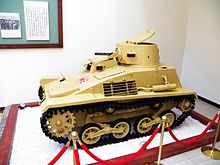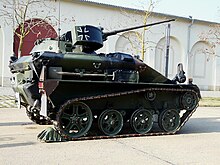Tankette


Atanketteis atrackedarmoured fighting vehicle[1]that resembles a smalltank,roughly the size of a car. It is mainly intended for light infantry support andscouting.[2][3]Colloquially it may also simply mean a small tank.[4]
Several countries built tankettes between the 1920s and 1940s, and some saw limited combat in the early phases ofWorld War II.The vulnerability of their light armour, however, eventually led armies to abandon the concept with some exceptions such as the more modern GermanWiesel(Weasel) series.
Characteristics[edit]
Tankettes were made both in two- and three-man models. Some were so low that the occupant had to lie prone.[3]Some models were not equipped withturrets(and together with the tracked mobility, this is often seen as defining the concept), or just a very simple turret that was traversed by hand or leg. They were significantly smaller thanlight tanksand did not have atank gun;instead their main weapon tended to be one or twomachine gunsor, rarely, a 20 mmautocannonorgrenade launcher.
History[edit]

The genesis of the tankette concept was thearmoured warfareofWorld War I.On theWestern Frontin the later stage of the war,Alliedtanks could break through the enemytrench linesbut theinfantry(needed to take and hold the ground gained) following the tanks were easily stopped or delayed by small arms fire and artillery. The breakthrough tanks were then isolated and destroyed, and reinforcements plugged the hole in the trench line. The tankette was originally conceived in the earlyinterwar periodto solve this problem.[citation needed]The first designs were a sort of mobile, one-manmachine gunnest protected against small arms fire and shell fragments. This idea was abandoned and the two man-model, mainly intended for reconnaissance, was produced instead. The moving up of infantry while protecting them was solved with the development of thearmoured personnel carrierconcept in the 1930s.

In 1925Britishtank pioneerGiffard Le Quesne Martelbuilt a one-man tank in his garage and showed it to theWar Office,who agreed to production of a few (known as theMorris-Martel) for testing. The publicity causedJohn CardenandVivian Loydto produce their own. Both types were developed further, but the two-manCarden Loyd tankettewas considered the classic and most successful design,[3]with many other tankettes modelled after it. While the design was influential, few Carden Loyd tankettes saw combat,[citation needed]other than those the Bolivian side used during theChaco War.However, the design did lead to the 'Bren Gun Carrier' which in final form as theUniversal Carrierhad an extensive operational history in the Second World War.[5]In 1928, theBritish Army Councilobjected to the use of the word "tankette," noting that the "mechanization of the Army" was still in its infancy.[6]
TheItalian Royal Army(Regio Esercito) equipped three armoured divisions and three "fast" (celere) divisions withL3/33andL3/35tankettes. The L3s were used in large numbers during theItalian invasion of Ethiopia,theSpanish Civil War,and almost every place Italian soldiers fought duringWorld War II.Some L3s went with theItalian Expeditionary Corps in Russia(Corpo di Spedizione Italiano,CSIR) as late asOperation Barbarossa.
TheFrencharmoured reconnaissance type (automitrailleuses de reconnaissance,"machine-gun scout" ) of the 1930s was essentially a tankette in form, specifically intended for scouting ahead of the main force.
In 1935, the Soviets experimented with transportingT-27sby air, suspending one under the fuselage of aTupolev TB-3heavy bomber.[3]

TheImperial Japanese Army(IJA) became one of the most prolific users of tankettes, producing a number of designs for reconnaissance and infantry support inSecond Sino-Japanese War[7]andjungle warfare.However, by the time of the Second World War, many were already obsolete and some were proven unsuccessful in their appointed task. Many were relegated totractorduties for artillery or logistics units.[3][8]
Due to their limited utility and vulnerability toanti-tank weapons(even machine guns), the tankette concept was abandoned, and their role largely taken over byarmoured cars.
However, inVietnam,theUS Marinesemployed the similar, somewhat larger,M50 Ontostank destroyer with some success.
The 1980s saw the renaissance of a similar concept in theGermanWiesel AWC,introduced to provide airborne troops with armoured reconnaissance capability;[9]while these are called "armoured weapons carriers", they fit the definition of a tankette.
Examples[edit]

- Czechoslovakia
- France
- Renault UE Chenillette
- Renault UE 57- a tank destroyer on UE chassis
- Nazi Germany
- Panzer I-Although classified as a light tank, most sub-variants fit the designation of a tankette
- West Germany
- Italy
- Japan
- Poland
- TKS/TK-3
- Romania
- Soviet Union
- T-17
- T-23
- T-27
- PPG tankette
- ASU-57assault gun
- United Kingdom
- United States
- Marmon-Herrington CTLS- not officially designated tankettes
- Ford 3-Ton M1918
See also[edit]
References[edit]
- ^Tedesco, Vincent J. III (2000),The Revolution After Next(PDF),Fort Leavenworth:School of Advanced Military Studies,p. 15, archived fromthe original(PDF)on 2012-02-13
- ^Sweet, John Joseph Timothy (2007),Iron Arm,Stackpole Books,p. 84,ISBN9780811733519– via Google Books
- ^abcdeT-27 Tankette(from the 'battlefield.ru' website, with further references cited. Accessed 2008-02-21.)
- ^Dickson, Paul (2004),War Slang: American Fighting Words and Phrases Since the Civil War,Brassey's, p. 221,ISBN9781574887105– via Google Books
- ^Fletcher & Bryan, p. 3
- ^"Objects to" Tankette. "; British Army Council Refuses to Sanction the Word".The New York Times.4 March 1928. p. 55.Retrieved1 July2022.
- ^Zaloga, Steven J.(2007),Japanese Tanks 1939–45,New Vanguard, Osprey Publishing, pp. 7, 10, 12,ISBN978-1-8460-3091-8
- ^U.S. Forces Encounter Old Jap Tankette(fromIntelligence Bulletin,September 1945, via lonesentry. Retrieved 2008-01-06.
- ^"Wiesel 1".Rheinmetall. Archived fromthe originalon 2007-09-27.Retrieved2008-05-29.
